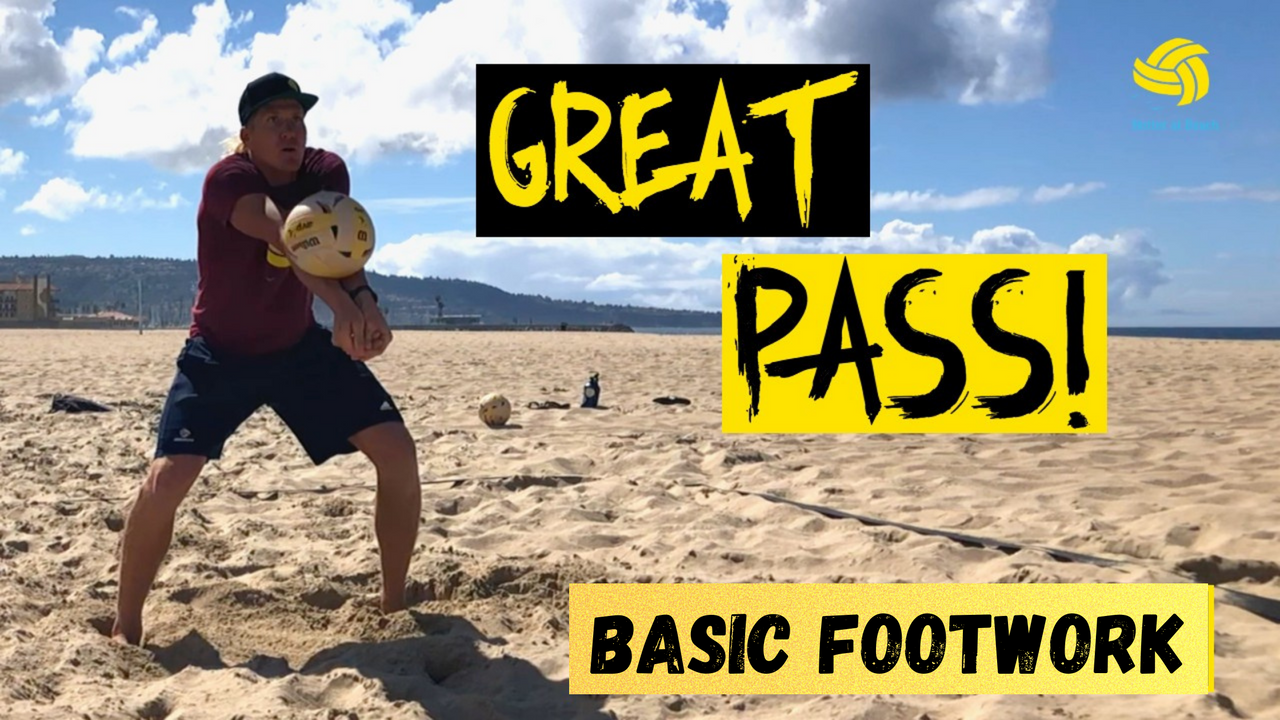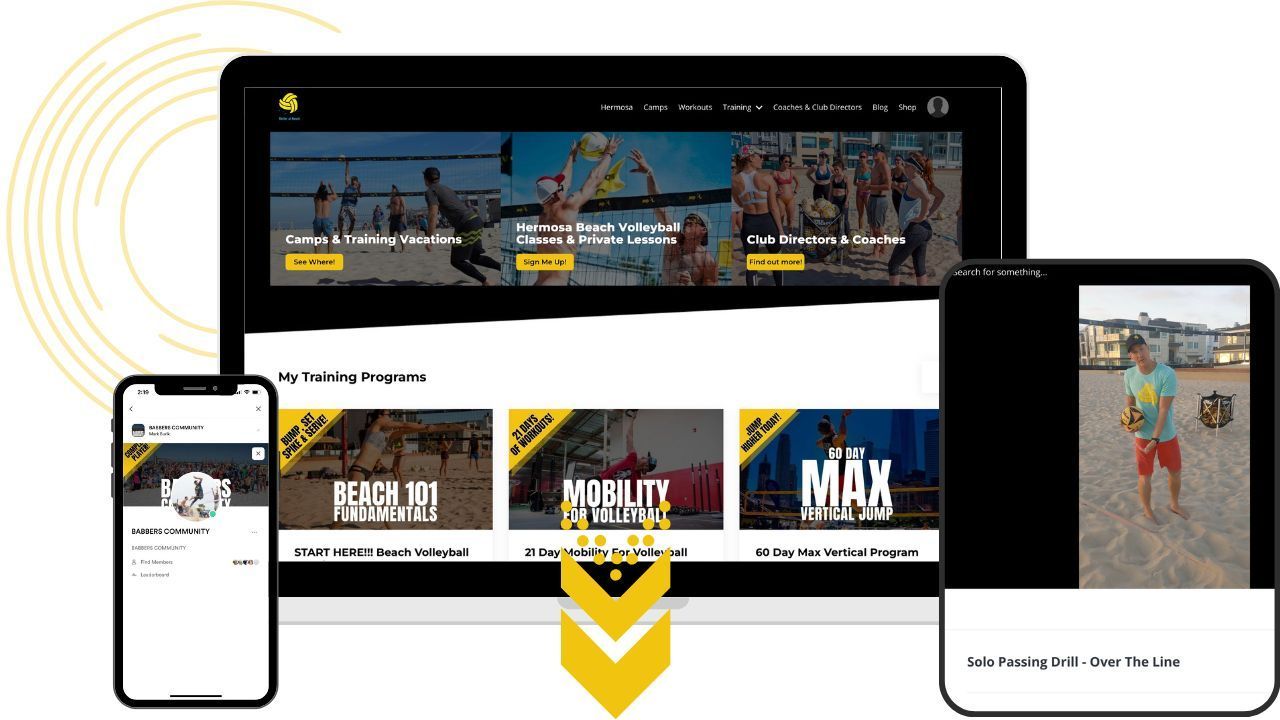
How to Pass A Volleyball - Basic Footwork and More
BASIC VOLLEYBALL FOOTWORK TO LEVEL UP YOUR GAME
Did you read "How to Master Passing a Volleyball in Beach Volleyball" and still missing the basic footwork skills?
This is where we cover the 5 Basics steps to begin and move into more advanced situations that will have you moving like a pro in no time.
Athletic Position and The Five Basics of Volleyball Footwork
- Athletic Position
- Lateral Steps
- Lateral Lunges
- Move 1 Move Both
- Step-Shuffle
- Backpedal
The Athletic Position for Volleyball
There is one posture that is common to almost all sports, and it’s called the athletic position. Regardless of the surface you compete on (sand, grass, hardwood, concrete), the athletic position is essentially a mandatory posture. Could be defense in basketball, preparing to field in baseball, or getting into serve receive in beach volleyball.
I tell my players I coach to “Learn to live in a quarter squat! We are beach volleyball athletes and we will spend years in the athletic position.”
The athletic position is where we begin our serve receive and both players will find themselves in it consistently throughout every point. It can be an intermediate position during transition between two different moves and it can be an “active waiting” position as it is in serve receive.
Generally speaking, the athletic position allows you to maximize your strength, power or speed in any direction. Changes in the angles of the ankles, knees and torso depend on the direction where we want to produce strength, power or speed.
For example, there are differences in stance with regard to the pure vertical power vs. lateral speed. Our defensive stance would be slightly different than our serve receive stance because a defender needs to be prepared to run laterally whereas a serve receiver only needs to run forward or shuffle laterally.
The quality of this position is not to be taken lightly. It can be properly groomed and perfected over years of training.
Feet
Our feet should be positioned just outside our shoulders. Too narrow and your lateral speed gets cut significantly; too wide and you will be stuck with a similar result.
Some researchers claim that a 50 degree angle from your heels to your belly button is ideal.
Knees
The knees should be just inside the feet so that we can create a better push off angle in order to get our body behind the ball in serve receive.
If your foot position is off or you don’t have the majority of the weight on the balls of your feet, you will lose precious bits of time getting to the best position.
Chest
The chest should be positioned just over feet with the back neutral, not hyper-extended. Most people think of a straight back and they puff their chest and stick their butt out. That is hyper-extension. It’s the end of your range. If your spine is not stacked properly and your core is not firmly activated, your movement will be slowed. Try not to puff your chest. Keep your bottom rib pointed down as opposed to flaring out in front of you.
Huge differences in players’ speed, agility and power have been accomplished simply by adjusting the tension and position of their hips and midsection.
Train yourself to find an athletic position that allows you to propel out of it without any further sinking or bouncing. Too many players lose time with a quick load phase or drop instead of getting directional immediately upon trajectory recognition.
Lateral Steps for Passing a Volleyball
Most serves in beach volleyball and indoor volleyball can be passed using only a single lateral step or less.
It’s important to move your lead foot first. If the ball is served on your left side, your left foot should pick up and get placed before your right foot. When the ball is served to your right side, your right foot should move first.
This allows for us to continue our efficient shuffle patterns when we have to move farther on the volleyball court.
Want to show your support and help us make more content?
Buy one of these cool beach volleyball gears...
 |
|
|---|---|
| Portable Volleyball Net Set System |
Lateral Lunges for Serve Receive and Defense
If a serve is absolutely rifled at you, you might be forced into a lateral lunge which is a big lateral step into a knee bend. Your lead knee should point and collapse outside your body so that you either sit softly without needing your hands or knee (specifically your patella) hits the sand or the court and stops your descent.
Most serves don’t approach us this fast but the lateral lunge can also come in handy when it’s time to play defense. Practice on the sand or a soft surface. If you are an indoor volleyball player, get your knee pads on. Point your right foot off the right side of your body, take a long lateral step and then softly collapse so your right shin lays parallel to the floor and your left (trail) leg is still straight.
When you can safely and softly get into this knee-down position, start practicing the lateral collapse by keeping both sets of toes pointed forward throughout the movement. Take a lateral step with your right leg and then shift the weight to your right heel as you softly let your tush touch down to the floor or sand. Try not to use your hands to catch you because you’ll need them to pass a volleyball while performing this footwork pattern. Better yet, if you really want to get ready for your next beach volleyball tournament (or indoor volleyball), try this passing drill for volleyball.
Have your partner toss balls low and outside your body so you can bump the volleyball back to them while practicing the shuffle footwork into a collapse. If you want to get your legs stronger and work on your mobility, don't ever put your hands down during this serve receive exercise.
And if you really want to get stronger, give our 60-day strength and conditioning course a try! We promise it'll get you in the best volleyball shape possible -- and we make it fun!
More often, as serve receivers, we have the time to move both feet and get ourselves truly balanced. Balance cannot be overlooked when learning how to bump a volleyball better.
When a player’s feet get too wide, they lose stability and balance and that leads to an angle that can’t be held. Getting too wide also prevents us from moving into our next position. Ideally, you can move both feet to the ball and get to a position that you would otherwise be able to stand in comfortably for a very long time. If you can’t get to the volleyball and pass from an easy, balanced position, your passing will suffer in the long run.
If you move one foot, hopefully, you can move the second one to re-establish your athletic position. There are a ton of beach volleyball drills for passing that teach you to dive but first, I’d recommend learning how to move quickly and stay on your feet.
STEP-SHUFFLE
The “Step-Shuffle” is a movement pattern that, again, keeps us in balance and moving efficiently.
When your feet stay just outside your shoulders and you maintain your athletic position, it’s easier to make your next athletic move. You can step-shuffle in all directions and it's critical to train your body in this movement pattern.
The Icky Shuffle is an agility drill that hoards of Brazilian players go through daily. I recommend giving it a look and get very comfortable moving like this.
Use the step shuffle when moving to balls served outside your body line. This will help you stay balanced and keep the ball in your center-line when you need to.
Try this lateral shuffle drill from our 60 Day Conditioning Program to help boost your agility.
BACK PEDAL TO FORWARD ROCK FOR SLOW DEEP SERVES
Some beach volleyball players, myself included, utilize the “rainbow” or “Jumbo” serve. The goal of this serve is to force the receiver to move their body deeper in the court to get their forearms on the ball or, even better for the server, force them into using a tomahawk.
Most players are uncomfortable and untrained in this type of serve receive. It can seem like a lolly pop serve, but amateur players everywhere get forced into tomahawks without even knowing that the server just took away their best passing tool, their platform!
The best serve receivers in the world never use a tomahawk in serve receive unless it is an absolute emergency. The best players in the world will go through entire seasons without using a tomahawk once in serve receive.
Just don't do it. It's tempting, yes. But don’t tomahawk in serve receive. Move your feet and use your platform to pass the volleyball with your forearms. What is a tomahawk? We will go more in depth into this in our Serve Receive Course in the Complete Player Program.

(Don't let this ^ happen to you on deep serves. It's not pretty.)
When we need to receive a slow, high, deep serve we should try to get our body behind the ball so it stays in our mid-line. We have to be quick with our back pedal because if we are still back-pedaling when we receive, it will take much longer to get to our hitting position and that has the potential to ruin our attack.
Back pedal quickly and beat the ball to its landing position so that you can rock forward and carry your momentum into your approach. This movement will lead to a much better offensive preparation and design.
If you're looking for a beach volleyball practice plan or just some great beach volleyball drills for passing and attacking, check out this one we recorded. It's great for teaching or reviewing how to pass in volleyball and it has great footwork drills for beach volleyball. As an AVP and FIVB professional beach volleyball player, I do volleyball passing drills for footwork at least twice a week.
After reading this blog and putting all the basic passing techniques together, it might be time to dive deeper into the world of arm swing mechanics and footwork for spiking volleyballs, join our
Complete Player - Attacking Mastery Course!
Get stronger and faster. Jump higher. Clean up your technique.
Learn where to be and when to be there from coaches and players who have done it at the highest level.
We guarantee you will win more matches.
It's finally time for you to play at the next level!
SIGN UP NOW AND LEARN HOW TO WIN FROM THE PROS.
🔥 💪 🏐 JOIN OUR EMAIL LIST + FREE BEACH VOLLEYBALL DRILL BOOK 🔥 💪 🏐
GET YOUR FREE BETTER AT BEACH DRILL BOOK
🔥 💪 🏐 DOWNLOAD 3 COMPLETE BEACH VOLLEYBALL WORKOUTS 🔥 💪 🏐
3 FREE WORKOUTS FROM BETTER AT BEACH
🔥 💪 🏐 SUBSCRIBE TO THIS CHANNEL 🔥 💪 🏐
BETTER AT BEACH YOU TUBE CHANNEL
🔥 💪 🏐 GET SOME VOLLEYBALL SWAG & SUPPORT OUR CHANNEL 🔥 💪 🏐
BETTER AT BEACH VOLLEYBALL SWAG
🔥 💪 🏐 BEACH VOLLEYBALL VACATIONS AND TRAINING CAMPS 🔥 💪 🏐
JOIN US FOR BETTER AT BEACH VACATIONS AND CAMPS
🔥 💪 🏐 WANT TO ORGANIZE A CLINIC IN YOUR HOMETOWN?!?! 🔥 💪 🏐
Email: [email protected]
🔥 💪 🏐 VOLLEYBALL EQUIPMENT 🔥 💪 🏐
🔥 💪 🏐 FOLLOW 🔥 💪 🏐
VolleyChat! Facebook’s #1 Beach Volleyball Group
https://www.facebook.com/groups/579978042710748
https://www.facebook.com/betteratbeac...
https://www.instagram.com/betteratbeach
TikTok
https://www.tiktok.com/@betteratbeach...
https://www.linkedin.com/company/bett...
https://www.pinterest.com/Betteratbea...
🔥 💪 🏐 MORE VIDEOS ON... 🔥 💪 🏐
Passing
https://www.betteratbeach.com/blog?ta...
Setting
https://www.betteratbeach.com/blog?ta...
Attacking
https://www.betteratbeach.com/blog?ta...
Serving
https://www.betteratbeach.com/blog?ta...
Defending
https://www.betteratbeach.com/blog?ta...
Blocking and Peeling
https://www.betteratbeach.com/blog?ta...
Strength and Conditioning for Volleyball
https://www.betteratbeach.com/blog?ta...
Practice Planning and Coaching Advice
https://www.betteratbeach.com/blog?ta...
Match & Video Analysis
https://www.betteratbeach.com/blog?ta...
***
Once you sign up for our Complete Player Program, you'll be able to watch the in-depth tutorials, film your “before” videos, start and film your at-home drills and begin posting to our Private Facebook Group. Then, our coaches will break down your mechanics and spacing and timing at our weekly online meetings. Yes, that means we look at YOUR videos and we coach YOU!
SIGN UP NOW AND LEARN HOW TO WIN FROM THE PROS.







